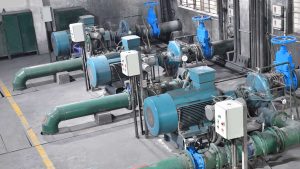By chance, have you ever wondered how float controls for pumps and lift stations actually work? Well, prepare to have your curiosity satisfied.
Float controls are essential for managing liquid levels within tanks and containers, ensuring optimal functionality and preventing overflow or underflow. These ingenious devices utilize a float that moves up and down with the liquid level, triggering a switch mechanism that controls the pump or lift station.
But how exactly does this process unfold? What are the different types of float controls available? And what benefits do they offer? The answers to these questions lie ahead, waiting to be revealed.
Stay tuned to uncover the inner workings of float controls for pumps and lift stations.
What Are Float Switches?
To fully comprehend the functionality and applications of float switches, it’s essential to understand the fundamental principles behind their operation. Float switch functionality is based on the rise and fall of a float attached to a switch mechanism. This mechanism can control pumps, alarms, or other devices based on liquid level.
When it comes to float switch design considerations, factors like liquid compatibility, operating temperature, mounting options, electrical ratings, and environmental conditions need to be considered. Troubleshooting float switches involves checking for issues such as mechanical blockages or electrical faults.
In terms of market trends, there’s a growing demand for float switches in various industries, leading to advancements in their design and technology. Float switch industry standards ensure that these devices meet specific criteria for reliability and performance.
Classifying Different Float Switches
Several types of float switches can be classified based on their design and mechanism of operation.
One type is the vertical float switch, which has a float that moves vertically along a guide tube. These switches are simple and reliable, but they may be prone to sticking if debris or sediment accumulates in the guide tube.
Tilt float switches, on the other hand, use a tilting mechanism to detect liquid levels. While they’re less susceptible to sticking, they may not suit liquids with high viscosity.
Magnetic float switches utilize a magnet inside the float to actuate a reed switch. They’re ideal for applications with aggressive or corrosive liquids.
Electronic float switches, which use sensors to detect liquid levels, are commonly used in industrial settings requiring precise level measurements.
When choosing a float switch for corrosive liquids, it’s important to consider the construction material and the switch’s compatibility with the specific liquid.
Float switches are crucial in preventing pump damage by turning the pump on or off based on liquid levels, ensuring that the pump doesn’t run dry or overflow.
Common Applications of Float Switches
Float switches are widely used in various industries and have proven reliable and cost-effective solutions for liquid-level sensing. They have a wide range of applications in industrial automation, liquid level monitoring, tank level control, and liquid level sensing.
Here are some common applications of float switches:
- Pump control: Float switches can be used to turn on or off pumps based on liquid levels, ensuring efficient operation and preventing damage to the system.
- Tank level monitoring: Float switches provide accurate level measurements, allowing for precise inventory management and preventing overfilling or running out of liquid.
- Overfill protection: Float switches can trigger alarms or shut off valves to prevent tank overflows, protecting against potential hazards and minimizing wastage.
Float switches play a crucial role in liquid level detection and are essential in various industries that rely on accurate and reliable liquid level sensing.
Benefits of Using Float Switches
One of the key advantages of using float switches is their versatility in various liquid-level sensing applications.
Float switches offer several benefits, making them a popular choice for many industries.
Firstly, they’re cost-effective, providing a reliable solution at an affordable price compared to other liquid-level sensing technologies.
Additionally, float switches are known for their simplicity and reliability, with a straightforward design that ensures accurate liquid level detection.
Their versatility is also a significant advantage, as they can be used with different types of liquids, such as water, oils, and chemicals.
Lastly, float switches require minimal maintenance and have a long lifespan, making them a reliable choice for long-term use.
Factors in Selecting Float Switches
When selecting float switches, it’s important to consider specific factors to guarantee optimal performance and compatibility with your liquid-level sensing application. Here are some key factors to keep in mind:
Float switch compatibility: Choose a switch that’s compatible with the type of liquid you’re measuring for accurate and reliable readings.
Float switch temperature range: Consider the temperature range in which the switch will be operating. Make sure it can withstand the temperature fluctuations without affecting its performance.
Float switch mounting methods: Determine the best mounting method for your specific application, whether it’s top, side, or bottom mounting.
Float switch electrical ratings: Check the switch’s electrical ratings to guarantee compatibility with your system’s voltage and current requirements.
Float switch environmental considerations: Take into account factors like humidity, vibration, and whether the switch will be used in hazardous areas. Check that the switch is designed to withstand these environmental conditions for long-term reliability.
Installation and Maintenance Tips
To ensure the proper functioning and longevity of your float switch, it’s important to follow these installation and maintenance tips.
First, troubleshooting is crucial if your float switch isn’t operating correctly. Check for loose or damaged wiring connections and make sure the switch is properly positioned.
Next, float switch calibration may be necessary to guarantee accurate level detection. Follow the manufacturer’s instructions for calibration procedures.
If your float switch is damaged or malfunctioning, repair may be required. Replace any broken components or faulty wiring to restore proper operation.
Regular cleaning of the float switch is also essential to prevent debris buildup that can affect its performance.
Lastly, if all attempts to fix the float switch fail, replacement may be necessary to make sure reliable liquid-level sensing.
South Florida Lift Station: Your Premier Partner in Pumping Solutions
South Florida Lift Station, with its extensive experience in the field, offers premier pumping solutions ranging from lift station repairs and sewage pumps to lift station sales and controls. They aim to help clients maintain their systems’ smooth running thanks to float switches’ versatility and effectiveness.
So, next time you see a pump or lift station at work, remember companies like South Florida Lift Station play a significant role in providing reliable solutions.








